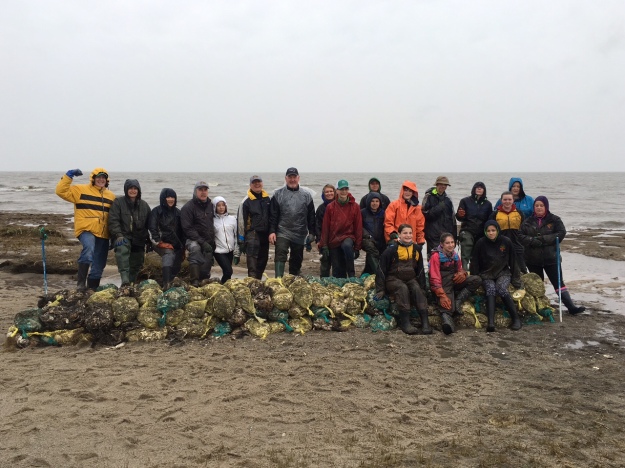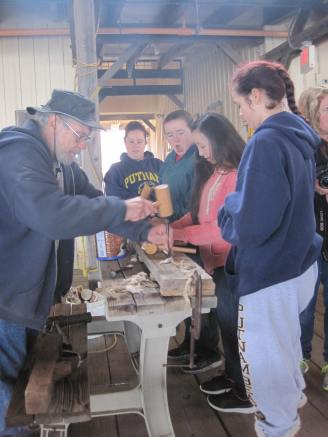The next generation of conservationists are getting a head-start in environmental stewardship thanks to Project PORTS — Promoting Oyster Restoration Through Schools, an education and community-based oyster restoration program supported by Rutgers University’s Haskin Shellfish Research Laboratory.

East Windsor Middle School student and families
For three days in early April, 8th grade students of East Windsor Middle School in Broad Brook, Connecticut, along with their parents and siblings, visited Cape May, New Jersey, to participate in Project PORTS. The interactive field trip included exploration, reflection, and action both in the classroom and out in the field.
“Some students learn best by listening, others by watching and some by doing — we were able to hit all aspects of learning through reinforcement in this program,” said Jenny Paterno, Program Coordinator at Rutgers University. “With this three day program, we could really bring a diverse suite of experiences to the students.”
The adventure began at the Nature Center of Cape May, where students received a simplified introduction to estuarine ecology, oyster biology and ecological restoration. The next morning, families joined staff from The Nature Conservancy (TNC), U.S. Fish and Wildlife Service, Rutgers University, and the Partnership for the Delaware Estuary to help install oyster reef breakwaters on Gandy’s Beach along the Delaware Bay in New Jersey. The students were able to apply some of the new knowledge gathered the day before to hands-on work in the field, and continued to build upon those new concepts throughout the day.
“The oyster reef structure will serve to slow down wave energy and reduce erosional forces while providing enhanced habitat for oysters, ribbed mussels, and a suite of other species,” said Paterno.
At the Gandy’s Beach project site, students worked together to pass oyster bags from one set of hands to the next, like an assembly line, to place them into position to form the breakwater structure. The brigade proved to be an efficient method to move the bags across the beach in an all-hands-on-deck style.

Shell brigade!
The materials used to create the shell bags are locally-sourced and New Jersey native. Project partner TNC collects clam and oyster shells from restaurants during scheduled weekly pickups in Atlantic City, and also receives donated surf clam shells from a local processing plant in Millville, New Jersey. The mollusk shells are then “cured” and distributed to schools where students construct the bags. Project PORTS works with over ten schools per year, primarily local students from Cumberland County, New Jersey.
The last stop for the East Windsor students was at the Rutgers University Aquaculture Innovation Center (AIC) in Cape May where various stations were set up for students to explore. Families learned about the culture of marine animals, tested their skill at shucking an oyster, examined oyster anatomy and viewed live oyster larvae and developing fish eggs.
In addition to learning about oysters, the students and their families were helping out with innovative coastal restoration work: building a living shoreline. Living shorelines incorporate a variety of structural and organic materials, such as sand or aquatic vegetation, to create a natural shoreline that protects and stabilizes the coast while providing habitat for native species.
The efforts of these students are part of a larger project. In 2013, U.S. Fish and Wildlife Service was awarded $880,000 from Hurricane Sandy resilience funds through Department of the Interior towards a living shoreline project at Gandy’s Beach. The project includes construction of 3,000 feet of living shoreline to restore the salt marsh and adjacent uplands. This work will improve the ability of the beach and neighboring communities to withstand future storm surges and coastal erosion, all while helping to stabilize the decreasing oyster population and enhance habitat for migratory birds, fish, and nearshore marine species.
The project is scheduled to be completed by November 8, 2016. Monitoring will continue for two years after the living shoreline is completed.
“[The project] will help stabilize approximately 3,000 feet of beach and tidal marsh shoreline,” said Katie Conrad, fish and wildlife biologist. “Ongoing monitoring will measure how well the oysters recruit on the different structures, so future restoration projects can benefit from what we have learned.”
Since the birth of the Gandy’s Beach living shoreline project in 2013, TNC and Project PORTS have involved several thousand local students in the ecological construction effort through the construction of shell bags as well as hands-on experience at the project site. To date, this reef has provided habitat for more than 20 million oysters and counting, according to Paterno. Even while only partially installed, the reefs have begun to provide habitat to young oysters.
The East Windsor Middle School students were able to embark on this stewardship adventure at Gandy’s Beach thanks to funding received from Pratt and Whitney’s Green Power Grant.
The benefits of educating future generations on environmental protection and awareness are more important now than ever. And when that education coincides with the enhancement of critical areas of coastal habitat— that’s a double victory.




Nice job reporting on a great collaborative effort!
Pingback: Four Years After Hurricane Sandy | U.S. Fish and Wildlife Service Northeast Region
Pingback: People Behind a Stronger Coast: Eric Schrading and Katie Conrad | U.S. Fish and Wildlife Service Northeast Region